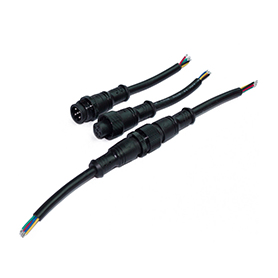News


News

From Design to Installation: 7 Deadly Wiring Mistakes with waterproof wire connectors marine and How to Avoid Them
Release time:2025-03-11
viewed:261
The reliability of a ship’s electrical system is critical to navigational safety, and proper installation of waterproof wire connectors marine plays a vital role. Statistics show that 30% of marine electrical failures stem from incorrect wiring practices, with 65% of these failures caused by improper installation of waterproof connectors. As a professional manufacturer of marine-grade waterproof connectors, we reveal the 7 most critical wiring mistakes and their solutions to help you avoid costly errors.

Error: Directly connecting copper-core cables to aluminum connectors.
Consequences:
Galvanic corrosion: Seawater acts as an electrolyte, accelerating oxidation between copper (cathode) and aluminum (anode), causing rapid corrosion and resistance spikes.
Data: Mixed-metal connections fail 5–8x faster, with lifespans reduced to 1–2 years.
Case Study: A fishing vessel nearly collided due to rudder signal failure caused by copper-aluminum corrosion.
Solution:
Use compatible metals: Opt for nickel-plated copper or stainless steel connectors.
Transitional measures: Add zinc sacrificial anodes or use insulating compounds (e.g., conductive grease).
Error: Forcing sharp bends at connector ports (bend radius <5x cable diameter).
Consequences:
Internal breaks: Shield or conductor fatigue leads to intermittent signals.
Seal failure: Stress cracks destroy waterproof seals, allowing leaks.
Case Study: A yacht’s radar lost 30% signal in rain due to cable over-bending.
Solution:
Minimum bend radius: Maintain ≥8x cable diameter (e.g., 48mm for 6mm cable).
Secure routing: Use nylon ties or metal clamps to fix cable paths.
Error: Installing cables tautly without expansion allowances.
Consequences:
Disconnected joints: Temperature shifts (-30°C to 70°C) cause ±2% cable length changes, pulling connectors loose.
Seal damage: Repeated stress wears out seals.
Solution:
Serpentine routing: Leave “S-shaped” slack (5cm per meter).
Flexible mounting: Use vibration-dampening clamps with rubber pads.
Error: Relying solely on connector waterproofing, neglecting external protection.
Consequences:
Capillary leaks: Moisture wicks along cable jackets (especially multi-strand wires).
Case Study: A cargo ship’s deck lights shorted due to saltwater ingress.
Solution:
Triple-layer sealing:
Wrap connectors with self-fusing tape (e.g., Scotch 2228).
Cover with adhesive-lined heat shrink tubing.
Apply silicone grease (e.g., Dow Corning DC4) to ports.
Error: Installing O-rings or gaskets backward.
Consequences:
Uneven pressure: Seals leak due to misalignment.
Data: Reversed seals have a 90% higher leak risk.
Solution:
Directional markings: Label “SEAL SIDE” on housings or use asymmetrical slots.
Training: Mandate seal orientation checks during installation training.
Error: Misusing industrial IP68 connectors for marine applications.
Consequences:
Salt spray failure: Industrial connectors fail IEC 60529 tests, corroding within 3 months.
Vibration issues: waterproof wire connectors marine require MIL-STD-167 compliance (industrial units fail at 1/3 stress).
Solution:
Certification: Choose products with DNV-GL, ABS, or LR certifications.
Material priority: Use 316 stainless steel or glass-reinforced nylon (PA66-GF30).
Error: Failing to ground connector shells or terminate shields.
Consequences:
Signal interference: Radar/communication errors spike due to electromagnetic noise.
Case Study: A research vessel’s GPS drifted 200m due to ungrounded connectors.
Solution:
Full shielding: Use cables with metal braiding, crimped to connector shells.
Redundant grounding: Ground at both equipment and deck terminals.
Installing waterproof wire connectors marine isn’t about “plug-and-play”—it demands precision and expertise. Avoiding these 7 mistakes reduces electrical failures by 80%.